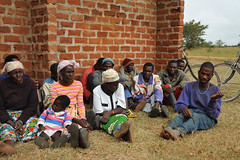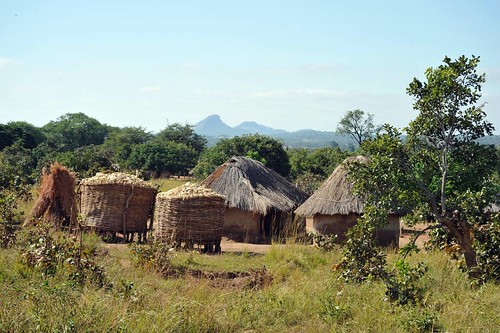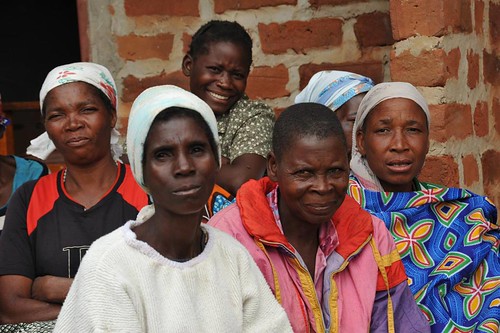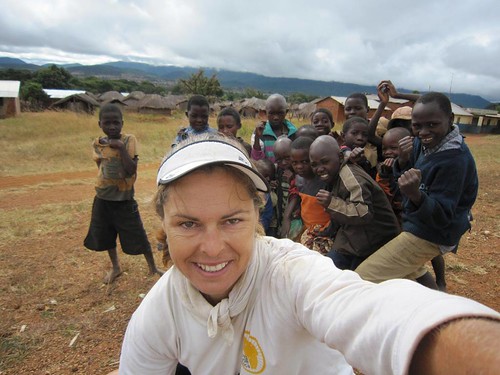Title: Lusaka to Lilongwe (Malawi), Plan Project in Chadiza
Dates: 12th to 18th May GPS:
Distance: 755km Total Distance: 15,021km
Roads: Good tarmac, hilly around Luangwa River
Weather: Cool evenings, warm days - and the usual headwinds
I set off for Lilongwe with a completely different team. John arrived back from Scotland after finishing seeding (on the farm) to replace Simon. Dan had decided to move on having been with us since the start. His knee is fine again, but since his injury he never regained his motivation to cycle, preferring to work solely as expedition support – which he was also brilliant at. He’s now back in the UK planning his next journey. Zdenek had to return to Europe for four weeks to sort a number of things out. He will rejoin the expedition in Kigali, Rwanda on 9th June. Therefore it was just John and I who set off from Lusaka. Actually the first day out on the road after the long break was my birthday, and so after receiving phone calls from each of my family members (and a whole stack of emails from friends), I set off from Kristin’s place (Kristin from World Bicycle Relief kindly put us up in Lusaka) out along the Great East Road, through Chongwe (WBR projects) and on. As John also had a bit to do to get ready, we decided that I should ride on my own for the day, then John drove out to collect me, returning to Lusaka so we could enjoy a celebratory birthday dinner. The next day we said goodbye to Kristin and drove to where I had reached the day before, 110km northeast of the city.
Zdenek had to return to Europe for four weeks to sort a number of things out. He will rejoin the expedition in Kigali, Rwanda on 9th June. Therefore it was just John and I who set off from Lusaka. Actually the first day out on the road after the long break was my birthday, and so after receiving phone calls from each of my family members (and a whole stack of emails from friends), I set off from Kristin’s place (Kristin from World Bicycle Relief kindly put us up in Lusaka) out along the Great East Road, through Chongwe (WBR projects) and on. As John also had a bit to do to get ready, we decided that I should ride on my own for the day, then John drove out to collect me, returning to Lusaka so we could enjoy a celebratory birthday dinner. The next day we said goodbye to Kristin and drove to where I had reached the day before, 110km northeast of the city.
Scenically the main road to Lilongwe was superb all the way; the gently undulating high plains near Lusaka morphed into big rolling hills and a couple of longer climbs around the Luangwa River, then back to high plains with rugged granite outcrops and isolated hills near Chipata, 600km from Lusaka. Chipata was our target for the four days. Travelling is simpler with just two and we share more of the normal duties such as cooking and cleaning. There is however, less flexibility. If John has to do some shopping for example, there is no one to watch the vehicle, and when he travels ahead to find a campsite (always hidden well away from the road), he then has to wait by the roadside for me to arrive rather than get on with setting up camp. All in all, we manage pretty well though.
As we headed east I noticed an increase in the level of poverty. More people, especially women and children would regularly beg and hold out their hands as I rode by. I saw people doing their washing in puddles beside the road. At Katete, 95km from Chipata we camped at a great place called Tiko’s. All proceeds from camping, accommodation and the bar/restaurant are ploughed back into an initiative set up by a German woman to assist people living with HIV/AIDS. There we met two VSO (Voluntary Service Overseas) workers, Alessandria and John. John worked at the nearby hospital. Alessandria, who is based in Chipata, offered for us to stay at her place while we visited the Plan project the next day.
In Chipata we met Benjamin Phiri, Plan Zambia’s Health Coordinator for the Eastern Province and facilitator for the Chadiza Programme Unit. Benjamin led our day excursion, firstly driving us about 80km over some rough roads to Chadiza. The town is tucked away in the south east corner of Zambia, not far from the Mozambique and Malawi borders. The road wound through small villages and fields of cotton, sunflowers and maize mostly. The countryside was studded with rugged hills; developing into a more comprehensive range towards the Mozambique border.
On the way we had time to discuss the HIV/AIDS situation in Zambia and learn a little about the project we were about to see. While we are focusing on a small part of the problem in Zambia, HIV issues are equally as serious in most countries in southern Africa. Currently about 90,000 Zambians are dying of AIDS each year leaving behind a growing number of orphans (993,000 orphans at present; 600,000 under the age of 17). About a third of Zambian children have lost at least one parent from AIDS. All parts of the society are affected, but the most vulnerable group are 15-24 year old women who are four times more likely to contract HIV than young men of the same age. Prevalence is highest among mothers aged 25-34 (approximately 19%) and among pregnant women (16.7%). A number of factors resulting from gender inequality contribute to the higher prevalence among women. Women are taught never to refuse their husband’s sex or to insist their partner use a condom. About 15% of Zambian women report forced sex, but as many will not disclose this information, the figure should most likely be higher. Young women usually become sexually active earlier than men with a partner who is on average five years older and who may have already had multiple sexual partners.
Mother to child transmission of HIV has serious implications for the survival and development of children. Thousands of these children are abandoned due to stigma or a lack of resources. Others run away because they have been mistreated or abused by foster families. There are many stigmas and much misinformation about HIV/AIDS and possible ‘cures’. One myth claims that sex with a virgin can cure AIDS! Unfortunately this has led to children contracting HIV after sexual abuse. In 2003, police handled 200 cases of child rape in a three month period, but experts believe that this is probably only ten percent of the real figure.
These statistics and facts are horrific, but some of the effects on the communities trying to absorb these tragedies are also alarming and contribute to keeping these people trapped in a cycle of poverty. Benjamin pointed out a couple of boys herding cattle along the side of the road. “These boys are orphans, bound into unfair contracts of forced labour”. From about the age of ten, they are taken in by ‘foster families’; contracted for usually four years to herd cattle with no pay, no school and no protection. Sometimes they are given shelter and perhaps food, but no protective clothing for the weather. Once their contract is up, they are ‘rewarded’ by being given an animal – perhaps a goat or a cow – which is usually in poor health and often dies within a few weeks. These boys reach their late teens illiterate, having had no parental guidance or role models.
Before visiting the project we collected a local reporter, Judith whom we had hired to help us film the meetings. Benjamin then took us to meet the Chief District Commissioner as a courtesy/PR visit. While we were there, the Member of Parliament for the Eastern Province arrived, so we met him too briefly. He was there to see how the new school and hospital were developing.
Finally we arrived at the Naviruli community in the Chadiza district, about an hour later. We were a little late, but the group of about 25 HIV/AIDS positive people had waited patiently. The Chadiza project has been funded by AusAID via Plan in Australia to reduce community vulnerability to HIV and AIDS from 2005 to 2009. In a nutshell, the programme involved firstly setting up and running support groups to educate about the affliction; encourage early diagnosis, acceptance and management. Secondly small plots of land were converted into vegetable gardens where those involved in the programme were educated about the importance of good nutrition and how to grow a variety of vegetables to achieve maximum productivity. They have also set up ‘banks’ and learned how to save any profits made from selling the excess produce.
 The group were a lively bunch. We must have sat out in the occasional drizzly rain for almost two hours. It was a little difficult to get the conversation going as I asked some general questions – I was a little cautious at first as I did not want to push them into discussing anything they might be sensitive about. I needn’t have worried though. The support group had been so successful in encouraging people to articulate about their illnesses and concerns, that they were accustomed to speaking about it. There have been (and still are in many communities) some real stigmas and discrimination attached to those with AIDS that this was a major deterrent preventing diagnosis and treatment. The formation of the support groups, I think are the cornerstone to the success of the programme. I asked a few people to describe the story of how they knew they had HIV/AIDS, what led them to take the test, how they deal with related ailments, and how they make a livelihood. The group members really opened up and it appeared as if it was therapeutic for them to describe their experiences. Sometimes I could see it was painful as they relived what they had been through, but they all seemed to finish with the positives.
The group were a lively bunch. We must have sat out in the occasional drizzly rain for almost two hours. It was a little difficult to get the conversation going as I asked some general questions – I was a little cautious at first as I did not want to push them into discussing anything they might be sensitive about. I needn’t have worried though. The support group had been so successful in encouraging people to articulate about their illnesses and concerns, that they were accustomed to speaking about it. There have been (and still are in many communities) some real stigmas and discrimination attached to those with AIDS that this was a major deterrent preventing diagnosis and treatment. The formation of the support groups, I think are the cornerstone to the success of the programme. I asked a few people to describe the story of how they knew they had HIV/AIDS, what led them to take the test, how they deal with related ailments, and how they make a livelihood. The group members really opened up and it appeared as if it was therapeutic for them to describe their experiences. Sometimes I could see it was painful as they relived what they had been through, but they all seemed to finish with the positives.
The group members shared the following:
- Signs of HIV included chronic malaria, diarrhoea, pains in the legs, skin blemishes and irritations or general body weakness.
- Testing – those that were counselled by people that Plan has trained in psycho-social counselling were advised to test for HIV, while others were encouraged by the health institutions as they sought remedies. I was told that when the headman of the village agreed to be tested, and was positive, it led many other men in particular, to get tested and face their own illnesses.
- Dealing with ailments – many are on anti retroviral (ARV) therapy. ARVs have had a huge effect, allowing people to become productive in their community once more.
- Livelihoods – almost all of them have been supported by Plan to maintain gardens; growing cassava, sweet potatoes, pumpkins, tomatoes, rape, aubergines, capsicums, cucumbers, beans, sugar cane and bananas. They said that they make around 100,000 Kwacha per month (approximately $20) from these gardening activities which they use mostly to meet their children’s school requisites, pay for milling maize, and buy household items like sugar, salt, or soap.
 I asked to see the vegetable garden and so after we finished our discussion, a few of the group members piled in to the back of the pickup and we drove a few kilometres to their plots for a tour. The member’s garden we focused on was impressive. On his small area of land he was able to produce enough for his family and the excess he sold. AusAID/Plan in Australia had provided training, tools and storage facilities. Part of the group therapy involved nutritional education as well as providing technical gardening skills. Traditionally rural Zambian diets are limited to maize, meat, potatoes, tomatoes and onions. There is little variety. By learning to grow and prepare a range of fresh produce, general health and immunities improved markedly. Along with all these usual vegetables, the moringa tree which we first came across in the Sahel region had been introduced. The powdered moringa leaves are like a ‘super food’, full of anti-oxidants and immune-boosting properties. I was very pleased to see the tree being used in the programme. He had built gravity irrigation channels to water his garden. Banana leaves were used as mulch and fertiliser added. Seeds supplied were in the form of a ‘seed loan’ which had to be repaid at the end of harvest. This project has been so successful that some of the group have been able to reduce, even live without their ARVs. It is certainly not a complete answer, but this initiative certainly helps.
I asked to see the vegetable garden and so after we finished our discussion, a few of the group members piled in to the back of the pickup and we drove a few kilometres to their plots for a tour. The member’s garden we focused on was impressive. On his small area of land he was able to produce enough for his family and the excess he sold. AusAID/Plan in Australia had provided training, tools and storage facilities. Part of the group therapy involved nutritional education as well as providing technical gardening skills. Traditionally rural Zambian diets are limited to maize, meat, potatoes, tomatoes and onions. There is little variety. By learning to grow and prepare a range of fresh produce, general health and immunities improved markedly. Along with all these usual vegetables, the moringa tree which we first came across in the Sahel region had been introduced. The powdered moringa leaves are like a ‘super food’, full of anti-oxidants and immune-boosting properties. I was very pleased to see the tree being used in the programme. He had built gravity irrigation channels to water his garden. Banana leaves were used as mulch and fertiliser added. Seeds supplied were in the form of a ‘seed loan’ which had to be repaid at the end of harvest. This project has been so successful that some of the group have been able to reduce, even live without their ARVs. It is certainly not a complete answer, but this initiative certainly helps.
One of the questions I asked of the group was “What were their biggest concerns?” They were all in agreement that the major worry was that their supply of ARVs would end. This would be like a death sentence. I couldn’t say anything then, but this is a real concern, not only for these people, but AIDS sufferers in many developing countries. Financial support for the treatment of AIDS from developed countries is dropping away, out of vogue, as the major donors are now focusing on more easily treatable diseases. ARVs need to be supplied for life and are expensive. Kristin from WBR sent me an alarming article, attached here as a PDF – personally this is more alarming now I can put some faces to the issues.
While I was in Zambia, I learned of the level of corruption the country has to try to absorb. A number of people have confirmed the same story. Apparently the president before the last president swindled 70% of the country’s health budget along with money from other departments. He was tried in the British High Court and found guilty, but back in Zambia, he was exonerated – they let him get away with it! It is difficult for Zambia to get the help it needs when donors can’t trust those who run the country. The European Union was all set to tarmac the road to Chadiza, but due to level of corruption, they pulled out of the project. Zambia is a beautiful country and should be doing better. It has a relatively low population, soil that can grow anything and a better infrastructure than most countries I have visited so far, but health issues amongst the majority poorer rural population is a serious concern.
In between discussions in the car we listened to the local radio. Chat shows and advertisements were constantly educating the public about their human rights, health and safety, fighting corruption, the need to vote and major community issues. Radio is the most powerful form of media as it reaches the biggest audience. People walk along the roadside with radios strung around their necks. We arrived back in Chipata just on dark. It was an enlightening day meeting a group of such positive people – with healthy minds and now healthier bodies. A great job has been done in Chadiza; one that has a sustainable future and that can be replicated. I thank all at Plan Zambia, especially Benjamin, Mwape and Tim Budge.
From Chipata, I did a long 155km day, across the border and in to Malawi. Initial impressions were being swamped by children’s friendly faces. In Lilongwe John and I were looked after by Globe Metals and Mining, an expedition sponsor, but more on our Malawi experiences in the next blog.






{ 1 comment… read it below or add one }
Good work,well done,how can the young people more especiary the drop-out from school need some skills to survive on.How can this be done?{Iam a student,MA,for Development Studies at Bugema University,Kampala, Uganda but a Zambian living in Eastern Province of Zambia